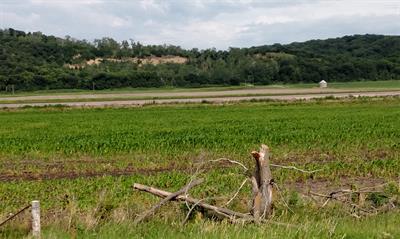 The calendar is rapidly moving through crop insurance planting deadlines and the wet weather seen in wide areas in the past few weeks has resulted in the 18-state planting progress dropping behind the five-year average. As of June 21, 90 percent of planned soybean acreage was seeded compared with an average of 95 percent, USDA reports. Iowa is just one percentage point behind normal, at 95 percent; Nebraska five points behind at 95 percent, and South Dakota two points ahead at 99 percent. Those really lagging behind the average include Kansas, with just 73 percent in the ground compared with a 91 percent average, and Missouri, with only 51 percent planted compared with 88 percent typically.
The calendar is rapidly moving through crop insurance planting deadlines and the wet weather seen in wide areas in the past few weeks has resulted in the 18-state planting progress dropping behind the five-year average. As of June 21, 90 percent of planned soybean acreage was seeded compared with an average of 95 percent, USDA reports. Iowa is just one percentage point behind normal, at 95 percent; Nebraska five points behind at 95 percent, and South Dakota two points ahead at 99 percent. Those really lagging behind the average include Kansas, with just 73 percent in the ground compared with a 91 percent average, and Missouri, with only 51 percent planted compared with 88 percent typically.
Producers who decide to forge ahead with soybeans during their late-planting period may want to follow the tips recently issued by the United Soybean Board (USB): Consider soil samples since flooded portions of fields may have different soil composition and textures. Look at genetics and switch to varieties that can better handle moisture-related diseases. When in the field, watch for muddy residue clogging machinery. Plant 1” to 1.25” deep to limit how long young plants are exposed to soggy soils.
Finally, USB recommends checking for slugs and fungal diseases, especially since the Climate Prediction Center’s July-September outlook favors above-normal rainfall and below-normal temps in the western Corn Belt, including most of the four-state region served by Farm Credit Services of America.
Bean emergence also is running slightly behind average as of June 21, three points behind the 87 percent average. Iowa is at 90 percent and Nebraska only 86 percent. South Dakota is well ahead of average, at 93 percent.
Condition ratings of soybeans in the 18 states are 65 percent good/excellent and just 8 percent poor/very poor. However, that is a few points worse than last week and quite a bit worse than last year’s 72 percent good/excellent and 5 percent poor/very poor.
USDA’s corn ratings have 71 percent good/excellent and 6 percent poor/very poor in the 18 states. This compares with 74 percent good/excellent and 12 percent poor/very poor as of June 23, 2014. Iowa is rated 83 percent in the top two categories against just 2 percent poor (last year, 79 percent and 5 percent). Nebraska currently is rated close to last year: 69 percent good/excellent and 6 percent poor/very poor in 2015 against 68 percent and 7 percent in 2014; South Dakota’s corn is 72 percent good/excellent and 4 percent poor, falling quite short of last year’s 81 and 2 percent.
Crop Insurance Reminders
Acreage reports are due at USDA by July 15, including any land that was late-planted, not planted, uninsurable or new to your operation. Producers should remember to provide their Farm Credit Services of America office with a copy of their 578s after certifying at FSA.
The rules regarding prevent-plant acres include holding a crop insurance policy that is not area-based (that is, not the type of coverage formerly known as GRP or GRIP); notifying your crop insurance specialist within 72 hours of deciding not to plant; meeting the 20/20 rule (the lesser of 20 acres or 20 percent of the crop acreage in the insured unit) and being in an area that qualifies for prevent-plant. Once your acres are released by an adjuster, you might want to consider a cover crop, for several reasons cited by agronomists: It may help control weeds, reduce insect and disease pressures, use applied fertilizer, improve soil and provide nitrogen (if it is a nitrogen-fixing crop). Many cover crops can be used as forage, but be aware of the strict rules regarding when you can harvest.
As the growing season continues, notify your insurance specialist immediately if you have any potential damage to your crops or if you have any questions about hail insurance coverage.
July 15 also is the deadline for purchasing annual forage coverage. Finally, have you paid your wheat crop insurance premium? If not, you’ll want to do so right away, before interest charges kick in.
If you aren’t already signed up for AgriPoint at fcsamerica.com, we encourage you to take advantage of all that it offers. AgriPoint provides convenient, 24/7 access to your FCSAmerica accounts where you can view the status of your crop insurance.

